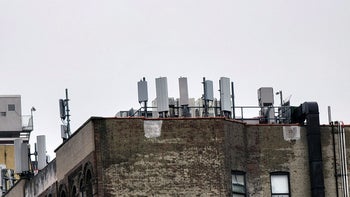Verizon vs T-Mobile 5G network test in New York: new C-Band deployment meets Sprint's spectrum

Verizon, T-Mobile, and AT&T scooped up billions worth of C-Band spectrum at last year's FCC auctions for the development of their next-gen 5G networks, and have now started its commercial deployment on a mass scale. Verizon lit up its 5G network expansion based on the purchased spectrum in 46 markets this week, while AT&T covered 8 major markets with its newly deployed C-Band 5G network.
Verizon spent more than $45 billion, nearly twice as much as the amount spent by AT&T. The latter picked up 1,600 licenses for $23 billion, but has added $9 billion more last fall, too. In contrast, T-Mobile added just $2.9 billion worth at the same fall auction that Verizon didn't take a part in, because the Un-carrier already has the strongest mid-band 5G presence of them all thanks to its merger with Sprint.
One storied network analyst, Sascha Segan from PCMag, has managed to test the new C-band efforts of Verizon in New York, and came away unimpressed when comparing it to T-Mobile's mid-band 5G network there.
Verizon vs T-Mobile 5G C-band network coverage and speed in New York
Despite Verizon's claims that this week's C-Band 5G launch covers 90 million people in 46 markets, the presence of its newfangled network in New York turned out to be scarcer than T-Mobile's ubiquitous 5G UC (for Ultra Capacity) there. The latter runs on Sprint's mid-band 2.5GHz spectrum, and has been in the deployment stage ever since the merger was approved by regulators, so T-Mobile has the timing advantage on its side, too.
Mr. Segan used a tailored Samsung Galaxy S21+, one of the few phones on Verizon that can take advantage of the new C-Band 5G frequencies, with a "carrier-grade" WIND Pro software supplied by the network-testing and research firm Ookla, the guys behind the Speedtest commercial app. a carrier-grade package that runs on altered phones.

Verizon's 5G UW icon can now mean C-Band connectivity as well
The WIND Pro app can be used not only for simple download and upload speed tests, but it also displays the current frequency band that the signal arrives on, as well as ways to test the call quality, text messaging, and video streaming peculiarities on those same 5G bands.
The new Verizon 5G network coverage and signal quality was put to the test by slumming it in East Harlem, from 96th to 125th Streets, plus areas in Queens like Long Island City, Sunnyside, Woodside, Astoria, Jackson Heights, Elmhurst, Rego Park, Forest Hills, and Kew Gardens. Here's what Sascha Segan and PCMag found during the testing phase:
- Verizon's C-Band uses 60MHz of new airwaves to provide faster, more reliable connections. The difference is noticeable, with considerably faster connections and less congestion.
- T-Mobile however, dominates New York City with their speedy, citywide "5G UC" performance - unmatched by other major competitors.
- When we found 5G connectivity, our test phone would automatically connect to millimeter-wave (as it's stronger than C-Band), but when out of mmWave range, or with mmWave turned off on the phone, it absolutely would not connect to C-Band. Verizon appears to be blocking access.
- Our tests showed that C-Band often just about doubled the speeds you'd get with an LTE phone.
- 5G is good right now, as its major advantage is that it lets devices use new airwaves. More airwaves mean more speed and less congestion.
- Splitting our tests between 4G and 5G components, we found that in T-Mobile tests, 75% of the speed came from 5G, while in Verizon's tests, 45-55% came from 5G.
Unfortunately, due to the new Federal Aviation Administration requirements regarding the C-Band network deployment that is suspected to interfere with planes' altimeter, most of the Queens neighborhood was part of the "5G exclusion zone," as it is right smack between two major airports. There Verizon appears to be blocking the mid-band 5G access even earlier than the required two-mile exclusion zone starting from the end of the runways. Verizon's ultrafast 5G mmWave network there, however, was dense enough to offset the New York airports 5G blues. We know what you are most interested at in the end, the Verizon vs T-Mobile 5G speeds there:

Verizon vs T-Mobile 5G mid-band speeds in Queens
The Un-carrier definitely delivered the faster speeds per MHz of spectrum, but we are still early in Verizon's C-Band deployment in New York, and Queens has those airport proximity restrictions we talked about earlier. As usual, Verizon's short-range mmWave network worked out to be the fastest 5G kid on the block, though.










Things that are NOT allowed: